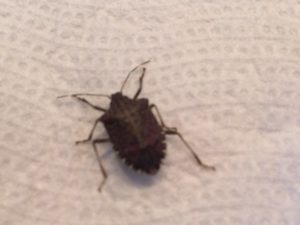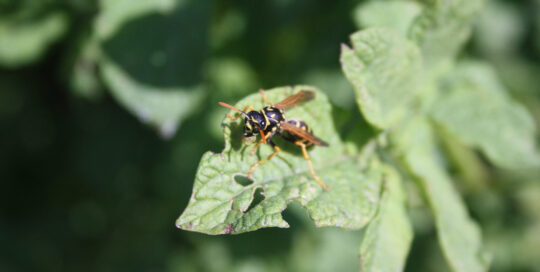Stink Bugs and Uninvited Pests
Views: 3416

In theory, if everything is balanced in the garden you shouldn’t have an issue with an overabundance of pests. The natural predators take care of the little darlings before they severely impact the landscape or crops. Well, unless they’re stink bugs.
But when you toss in invaders from foreign countries all bets are off. We’re out of balance because we dont have the same predators to take care of them. These uninvited invaders strike fear into the hearts of gardeners.
The Brown Marmorated Stink Bug
Today, when I had a couple of fellow gardeners over for lunch, we talked about everything from kudzu to the latest pest to make the news. My friend Chris said there’s a stink bug from China that can have a dreadful impact to those of us who love to grow things.
I have a feeling she’s talking about the brown marmorated stink bug. The tough thing is there are roughly 250 native stink bug species so its hard to distinguish the bad guy unless you have the chance to take a closer look at it. It has a gray and brown mottled coloration, but the most recognizable feature is the alternating light and dark segments on the end of their antennae. It first showed up in 2001, and now has dug in its little segmented legs from New Jersey to Pittsburgh, as well as in California and Oregon.
These most likely came to the States by hitching a ride on packing materials in products arriving in the country. This isn’t the case with others. Sometimes we are our own worst enemy.
Dangers of Uninvited Pests
Back in the 1970’s, scientists realized releasing the gall fly (Urophora affinis and U. quadrifasciata) from Europe was effective on keeping the spotted knapweed (since it originated in Europe) under control in Montana. The flies lay their eggs in the seed heads, then the larvae eats into the seed head and is eventually encased in a calloused area until they emerge the following year.
Sounds fabulous, doesnt it?
Well, what they didnt consider is the native deer mouse, who arent stupid particularly when it comes to food, discovered the pupa were pretty tasty. Consequently, the deer mouse population exploded, and thats when hanta virus reared its ugly head.
Things like this are hard to predict.
A similar situation occurred, in the early 1900s as well as later, when the federal government brought in the multicolored Asian lady beetle (Harmonia axyridis) to battle aphids damaged pecan orchards in California and the Southeast. They did a bang up job of eating the aphids, but continued on to eat native lady beetles. In reality, it completely wiped out the state insect of New York, the nine-spotted lady beetle, in that state.
Lady Beetles
Plus, the prolific lady beetles are the ones most known for home invasions in the latter part of the fall in some areas of the country. If you have hoards of them gathering on or in your house, its most likely the multicolored Asian variety. They also bite, although its not in defense. Its more of a curious nibble, but not something expected from an adorable lady bug. What they do use for defense is far less lady like. They emit blood with a foul odor, so you can imagine what they smell like if you squish them.
As if we didnt have enough issues with our homegrown pests, we have to worry about those from other countries who come in for a free for all. No predators. No natural controls. Good times. Thankfully, I think our agricultural scientists are far more aware of these concerns, plus with knowledge of insects hitching rides on containers there are more watchful eyes making sure it doesnt happen.
(The photo of the brown marmorated stink bug is copyright of ibunt via iStock. Thank goodness I haven’t seen one up close and personal…yet.)
Meet Amy Grisak
Amy is a freelance author and photographer in Great Falls, MT who specializes in gardening, foods, and sustainable agriculture. She provides information on every kind…
Amy's Recent Posts

Looking into the Crystal Ball for a Pest Report








